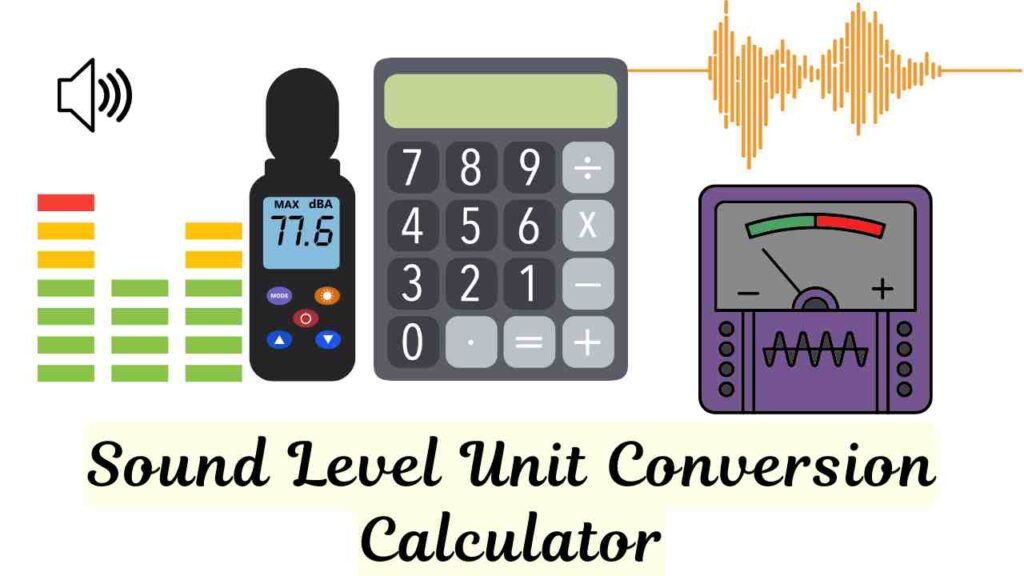Sound Level Unit Converter
Sound is an integral part of our daily lives, from the soothing hum of nature to the roar of urban environments. Whether you're an audio engineer designing sound systems, a scientist studying noise pollution, or simply someone curious about how sound levels are measured, understanding and converting between sound level units is essential. However, switching between units like Decibels (dB), Bel (B), Nepers (Np), Phons, and Sones can be challenging without the right tools.
To simplify this process, we’ve developed a free, intuitive online Sound Level Unit Conversion Calculator that allows you to convert between any sound level units instantly. In this blog post, we’ll explore why sound level conversions matter, common scenarios where they’re needed, and how this calculator can help you work smarter.
Sound Level Unit Conversion Calculator
Table of Contents
Sound levels are measured in various units depending on the context and application. The most commonly used units include:
- Decibel (dB) : The standard unit for measuring sound intensity, widely used in acoustics and audio engineering.
- Bel (B) : A larger unit equivalent to 10 Decibels, often used in telecommunications.
- Neper (Np) : A logarithmic unit used in electrical engineering and acoustics to measure ratios of power or amplitude.
- Phon : Measures perceived loudness at a specific frequency, closely related to Decibels but adjusted for human hearing sensitivity.
- Sone : Represents subjective loudness as perceived by the human ear, with 1 Sone corresponding to a 40 dB sound at 1 kHz.
Each unit serves a specific purpose, and converting between them ensures consistency and accuracy in calculations.
Why Convert Sound Level Units?
Converting between sound level units is crucial for several reasons:
- Cross-Disciplinary Work : Different fields use different units. For example, engineers might work in Decibels, while audiologists focus on Phons and Sones.
- Precision in Measurements : High-precision applications, such as noise control or hearing protection, require accurate conversions between units.
- Compatibility : When integrating systems or tools that use different units, conversions ensure seamless operation.
- Education and Research : Students and researchers often need to compare data across multiple scales, making unit conversions indispensable.
- Real-World Applications : From assessing environmental noise levels to designing soundproofing systems, unit conversions play a vital role in countless industries.
Introducing the Sound Level Unit Conversion Calculator
To simplify the process of converting sound level units, we’ve developed a free, easy-to-use online Sound Level Unit Conversion Calculator . This tool allows you to convert between any two units instantly while also providing a comprehensive list of all possible conversions for your input value.
How It Works
- Enter the Value : Input the numerical value you want to convert.
- Select "From" and "To" Units : Choose the unit you’re converting from (e.g., Decibels) and the unit you’re converting to (e.g., Bel).
- Click "Convert" : The calculator will display the converted result for your selected "to" unit.
- View All Conversions : Below the main result, you’ll find a grid showing the equivalent values in all supported units, giving you a complete overview.
Example Conversion
Let’s say you have a sound level of 80 Decibels (dB) and need to determine its value in Bel:
- Enter
80in the input field. - Select "Decibel (dB)" as the "from" unit and "Bel (B)" as the "to" unit.
- Click "Convert."
The calculator will show:
- Main Result :
80 Decibels (dB) = 8 Bel (B) - All Results Grid :Copy12345Decibel (dB): 80Bel (B): 8Neper (Np): 9.21034Phon: 80Sones: 63.095734
This instant overview saves time and ensures accuracy in your calculations.
Key Features of the Calculator

- Dynamic Dropdowns : Automatically populated with all supported units for quick selection.
- Responsive Design : Works seamlessly on desktops, tablets, and mobile devices.
- Scientific Precision : Handles large and small numbers with ease, displaying results in either standard or scientific notation.
- Comprehensive Results : Provides not just the specific conversion but also a full breakdown of all equivalent values.
- User-Friendly Interface : Clean, intuitive design with hover effects for better readability.
Practical Applications of the Calculator
Here are some real-world scenarios where this calculator can be invaluable:
- Acoustics Engineering : Convert between Decibels and Nepers when designing soundproofing systems or analyzing sound propagation.
- Audio Production : Translate sound levels into Phons for equal-loudness contour analysis or mixing adjustments.
- Environmental Science : Measure noise pollution in Decibels and compare it to human-perceived loudness in Sones.
- Health and Safety : Assess noise exposure limits in Decibels and convert them to other units for reporting or compliance purposes.
- Education : Help students understand the relationships between different sound level units through hands-on exploration.
Tips for Using the Calculator Effectively
- Double-Check Inputs : Ensure the value and units you enter are correct to avoid errors.
- Understand Context : Know which unit is most appropriate for your application before performing conversions.
- Explore All Results : Use the "All Results" grid to gain insights into how different units compare.
- Bookmark the Tool : Save the calculator link for quick access whenever you need it.
Conclusion
Understanding sound level units and their conversions is a critical skill in many fields, from audio engineering and environmental science to health and safety. With our Sound Level Unit Conversion Calculator , you can streamline this process and focus on what truly matters—your work. Whether you’re designing sound systems, studying noise pollution, or solving complex problems in acoustics, this tool empowers you to handle sound level conversions with confidence and precision.